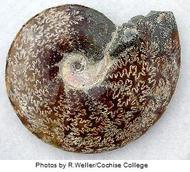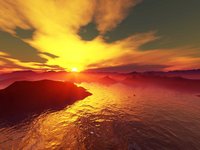Cephalapod Fractals
 Thursday, May 15, 2008
Thursday, May 15, 2008 
Complex SutureSteve LaMonte, a student in my Fall 2007 version of Chaos and Fractals, has noted the fractal-like shapes that are formed by suture lines in ancient cephalopods. He points out the correlation between fractal structure and the ability of the cephalopod to withstand extremes of water pressure. He writes:
One often pictures fractals as consisting of pretty pictures generated by computer programs, but they are quite prevalent in nature. A notable example can be found in the fossils of ancient cephalopods, specifically nautiloids and ammonoids. Nautoloids and ammonoids are the ancient ancestors of modern squids, octopi, and the nautilus. The ancient organisms looked like modern squids and octopi with shells, some elongated and some coiled like a snail. These shells had internal chambers that the organism filled with gas for buoyancy. Each chamber is separated by a wall, or septa. The contact line between the septa and the inner shell wall is called a suture line. The structure of the suture line determines how well the organism can resist water pressure and adjust its buoyancy. The evolution of suture lines follows an increasingly fractal-like pattern from straight sutures to highly undulated sutures. In complex sutures, the dips and folds in the undulations are called lobes and saddles, respectively.









